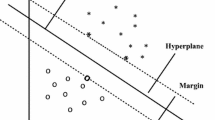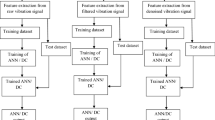Abstract
Bearing condition monitoring is significant in industries due to increased machine reliability and decreased production loss due to machinery breakdown. With the advancement of Artificial Intelligence (AI), Machine Learning (ML) techniques are reasonably useful to build condition monitoring systems for real-world applications. ML algorithms help distinguish faulty bearings from healthy ones and classify the related fault types using the extracted time-domain and frequency-domain features. This study recognizes distinctive features or condition indicators that effectively separate different fault groups and are worthy of training an ML model. Box plot and scatter plot of fault features are used to identify these condition indicators. Vibration datasets representing various faults are taken from the open-source Case Western Reserve University (CWRU) bearing database. A number of time-domain features are extracted from the ensemble data of bearing fault classes, consisting of healthy bearing, inner race fault, ball fault, and outer race fault. Our investigation indicates that more than one condition indicator is better for separating the fault categories. Six different ML models are trained using the condition indicators and the best-performing model is found through the classification accuracy, training time, and prediction speed of the classifier.
Access this chapter
Tax calculation will be finalised at checkout
Purchases are for personal use only
Similar content being viewed by others
Abbreviations
- CWRU:
-
Case Western Reserve University
- \(CF\):
-
Crest Factor
- \(IF\):
-
Impulse Factor
- \({K}_{u}\):
-
Kurtosis
- REB:
-
Rolling Element Bearing
- \({S}_{k}\):
-
Skewness
- \(\overline{X}\):
-
Mean
- \(\sigma\):
-
Standard Deviation
References
McArthur SDJ, Strachan SM, Jahn G. The design of a multi-agent transformer condition monitoring system. IEEE Trans Power Syst. 2004;19(4):1845–52. https://doi.org/10.1109/TPWRS.2004.835667.
Goyal D, Pabla BS. The vibration monitoring methods and signal processing techniques for structural health monitoring: a review. Arch Comput Methods Eng. 2016;23(4):585–94. https://doi.org/10.1007/s11831-015-9145-0.
Sehgal S, Kumar H. Damage detection using derringer’s function based weighted model updating method. Conf Proc Soc Exp Mech Ser. 2014;5:241–53. https://doi.org/10.1007/978-3-319-04570-2_27.
Glowacz A. Fault diagnosis of single-phase induction motor based on acoustic signals. Mech Syst Signal Process. 2019;117:65–80. https://doi.org/10.1016/j.ymssp.2018.07.044.
Younus AMD, Yang BS. Intelligent fault diagnosis of rotating machinery using infrared thermal image. Expert Syst Appl. 2012;39(2):2082–91. https://doi.org/10.1016/j.eswa.2011.08.004.
Lim GM, Bae DM, Kim JH. Fault diagnosis of rotating machine by thermography method on support vector machine. J Mech Sci Technol. 2014;28(8):2947–52. https://doi.org/10.1007/s12206-014-0701-6.
Vass J, Šmíd R, Randall RB, Sovka P, Cristalli C, Torcianti B. Avoidance of Speckle noise in laser vibrometry by the use of kurtosis ratio: application to mechanical fault diagnostics. Mech Syst Signal Process. 2008;22(3):647–71. https://doi.org/10.1016/j.ymssp.2007.08.008.
Tokognon Jr. CA, Gao B, Tian GY, Yan Y. Structural health monitoring framework based on internet of things: a survey. IEEE Internet Things J. 2017;4(3):619–635. https://doi.org/10.1109/SYSCO.2016.7831328.
Shi DF, Wang WJ, Qu LS. Defect detection for bearings using envelope spectra of wavelet transform. J Vib Acoust Trans ASME. 2004;126(4):567–73. https://doi.org/10.1115/1.1804995.
Pudil P, Novovičová J, Kittler J. Floating search methods in feature selection. Pattern Recognit Lett. 1994;15(11):1119–25. https://doi.org/10.1016/0167-8655(94)90127-9.
Haj Mohamad T, Samadani M, Nataraj C. Rolling element bearing diagnostics using extended phase space topology. J Vib Acoust Trans ASME. 2018;140(6):1–9. https://doi.org/10.1115/1.4040041.
Widodo A, Yang BS. Support vector machine in machine condition monitoring and fault diagnosis. Mech Syst Signal Process. 2007;21(6):2560–74. https://doi.org/10.1016/j.ymssp.2006.12.007.
Jamil MA, Khan MAA, Khanam S. Feature-based performance of SVM and KNN classifiers for diagnosis of rolling element bearing faults. Vibroeng Procedia. 2021;36–42. https://doi.org/10.21595/vp.2021.22307.
Pandya DH, Upadhyay SH, Harsha SP. Fault diagnosis of rolling element bearing with intrinsic mode function of acoustic emission data using APF-KNN. Expert Syst Appl. 2013;40(10):4137–45. https://doi.org/10.1016/j.eswa.2013.01.033.
Jamil MA, Khanam S. Fault classification of rolling element bearing in machine learning domain. Int J Acoust Vib. 2022;27(2):77–90. https://doi.org/10.20855/ijav.2022.27.21829.
Zhou H, Chen J, Dong G, Wang H, Yuan H. Bearing fault recognition method based on neighbourhood component analysis and coupled hidden markov model. Mech Syst Signal Process. 2016;66–67:568–81. https://doi.org/10.1016/j.ymssp.2015.04.037.
Xia M, Li T, Shu T, Wan J, De Silva CW, Wang Z. A two-stage approach for the remaining useful life prediction of bearings using deep neural networks. IEEE Trans Ind Inform. 2019;15(6):3703–11. https://doi.org/10.1109/TII.2018.2868687.
Case Western Reserve University (CWRU) Bearing Data Center [Online]. https://csegroups.case.edu/bearingdatacenter/pages/welcome-case-western-reserve-university-bearing-data-center-website.
Author information
Authors and Affiliations
Corresponding author
Editor information
Editors and Affiliations
Rights and permissions
Copyright information
© 2023 The Author(s), under exclusive license to Springer Nature Singapore Pte Ltd.
About this paper
Cite this paper
Jamil, M.A., Khanam, S. (2023). Identifying Condition Indicators for Artificially Intelligent Fault Classification in Rolling Element Bearings. In: Tiwari, R., Ram Mohan, Y.S., Darpe, A.K., Kumar, V.A., Tiwari, M. (eds) Vibration Engineering and Technology of Machinery, Volume I. VETOMAC 2021. Mechanisms and Machine Science, vol 137. Springer, Singapore. https://doi.org/10.1007/978-981-99-4721-8_22
Download citation
DOI: https://doi.org/10.1007/978-981-99-4721-8_22
Published:
Publisher Name: Springer, Singapore
Print ISBN: 978-981-99-4720-1
Online ISBN: 978-981-99-4721-8
eBook Packages: EngineeringEngineering (R0)




